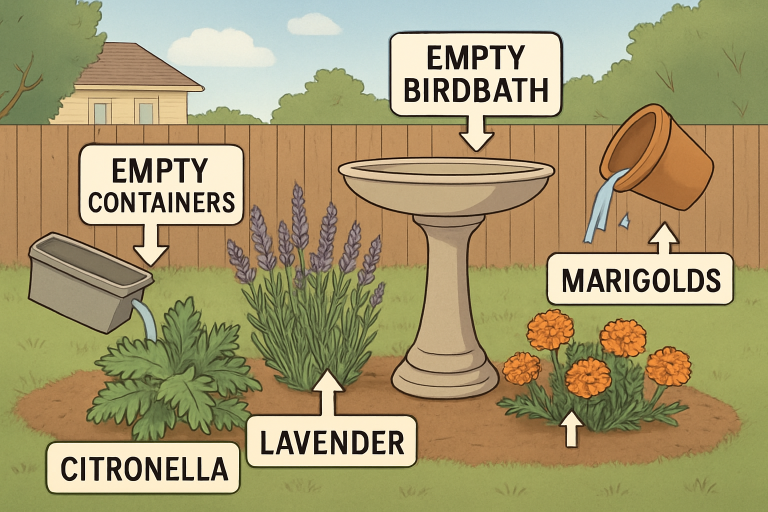Key Takeaways
- Eliminate standing water to disrupt mosquito breeding cycles.
- Utilize natural repellents and plants to deter mosquitoes.
- Employ physical barriers and innovative traps for added protection.
- Engage in community efforts for comprehensive mosquito control.
Introduction
As summer approaches, homeowners face the annual challenge of keeping mosquitoes at bay. These persistent insects are more than annoying—their bites can leave behind itchy welts. They can also transmit serious illnesses, such as the West Nile virus, Zika virus, chikungunya, and dengue fever. For families with young children, the elderly, or immunocompromised individuals, the risk is even greater, making effective mosquito prevention go hand in hand with health and safety. While some homeowners may feel their efforts are sufficient, tackling significant infestations or persistent populations usually requires support from highly trained professionals. In these instances, don’t hesitate to connect with professional mosquito control services in Tulsa, especially when you need lasting, expert-supported results.
Each household can benefit from a comprehensive mosquito prevention strategy that combines multiple approaches. By integrating practical do-it-yourself tips with the latest innovations in environmental and chemical controls, homeowners can shape a living environment that naturally discourages mosquitoes from breeding, biting, or sticking around. Read on to discover actionable, practical, and even cutting-edge solutions to help keep these troublesome pests out of your home and away from your family throughout mosquito season.
Eliminate Standing Water
Standing water is the number one invitation for mosquitoes to shop on your property. Mosquitoes require stagnant water to lay their eggs, and just a few days of neglected pooling is all it takes for larvae to mature. Female mosquitoes seek out even the smallest, often-overlooked pools—think clogged gutters brimming with rainwater, unused buckets tossed in the corner of the yard, birdbaths, or a single tire left by the garage. Homeowners should routinely comb their properties for these breeding spots and remove, empty, or treat them to break the mosquito life cycle. Don’t ignore less obvious sources like children’s toys, plant saucers, tarps, garbage can lids, or pet bowls where water may accumulate after rainfall. Proactive measures such as improving drainage across the yard, leveling out depressions, and cleaning out gutter debris several times each season are simple yet immensely effective steps that can significantly decrease mosquito populations over time.
Natural Repellents and Plants
Many homeowners search for solutions that protect their loved ones without introducing chemicals into their environments. Fortunately, many common plants emit natural fragrances that mosquitoes find unpleasant or disorienting. Citronella grass, for example, is a highly effective repellent and makes an attractive addition to any garden. Lavender, marigolds, basil, lemongrass, and various types of mint are also renowned for their mosquito-repelling properties. Planting these botanicals near outdoor seating areas, patios, or windows can provide a constant, low-maintenance barrier. Additionally, essential oils derived from these plants—such as citronella, eucalyptus, peppermint, or lavender oil—can be incorporated into homemade sprays or diffused throughout indoor spaces to add another line of defense. When used safely and following expert recommendations, as detailed by AP News, these essential oils can be as effective as some commercial chemical repellents.
Beyond repelling mosquitoes, many of these plants also attract pollinators and enhance landscape aesthetics. Small changes in your home’s landscaping plan, such as creating borders with marigolds or tucking pots of basil and mint around entrances, can bolster your garden’s natural resistance against mosquitoes while boosting its beauty.

Physical Barriers and Innovative Traps
Creating a literal barrier between your living space and the outdoors remains one of the most reliable ways to keep mosquitoes out of your home. Installing or repairing fine-mesh screens on all windows and doors prevents mosquitoes from slipping inside, even when you want to enjoy a cool breeze. For extended outdoor gatherings, camping, or if you like to leave windows open overnight, high-quality mosquito nets or mesh curtains offer an additional layer of protection. These measures are essential for families with infants or elderly members who may be more susceptible to viruses carried by mosquitoes.
Beyond tried-and-true protection, technology brings a wave of innovative traps designed to cut down on mosquito numbers outdoors. The “Mosquito Bucket of Doom,” for instance, is a cost-effective DIY option that uses water, organic matter, and a biological larvicide called Bacillus thuringiensis israelensis (Bti) to target larvae before they mature. Unlike broad-spectrum insecticides, Bti specifically attacks mosquito larvae without harming beneficial insects, wildlife, or pets. These traps should be placed in shaded corners, near water sources, or areas where mosquitoes congregate, ensuring new generations are stopped before they hatch.
Community Engagement
Mosquitoes do not respect property lines, and solitary efforts can go unrewarded if neighboring yards offer ideal breeding grounds. Neighborhood-level cooperation is among the strongest strategies for meaningful, large-scale mosquito control. Consider organizing periodic cleanup events with neighbors, encouraging everyone to check for and eliminate sources of stagnant water regularly. Sharing educational materials and resources can also increase awareness and participation. By working together to remove refuse, old tires, and items that trap water, entire blocks can reduce mosquito populations. Community engagement extends to working with local health departments and municipal authorities, providing feedback or participating in programs targeting high-risk areas. Some neighborhoods use crowd-sourced data to report or map out stagnant water locations, empowering city crews to take targeted action.
Innovative Technologies
Recent advancements in technology are transforming the mosquito control landscape. The development and deployment of AI-enabled surveillance and robotic technologies are revolutionizing how communities monitor, respond to, and target mosquito breeding areas. Robotic solutions like the “Dragonfly” can traverse large expanses while collecting data and applying treatments in real time. Such precision means mosquito control efforts can be directed where activity is detected rather than broadly applied.
Perhaps most exciting, genetic engineering and biological control breakthroughs have opened new frontiers in population suppression. Genetically modified mosquitoes that are sterile or unable to mature are being released in select U.S. communities to dramatically reduce populations over several generations, minimizing reliance on widespread chemical use. Research detailed by Time shows these innovative strategies lower mosquito density and reduce the risk of mosquito-borne disease transmission without environmental fallout.
Personal Protective Measures
While environmental adjustments are essential, personal protection is just as important, especially if you plan to be outdoors during peak mosquito hours, typically early morning and late evening. Dress in light-colored, loose-fitting long sleeves, pants, and closed shoes to cover exposed skin. Applying EPA-approved insect repellents on skin and outer clothing further decreases your risk of being bitten. Look for active ingredients like DEET, picaridin, IR3535, or oil of lemon eucalyptus, and always follow label instructions for safe and practical application. Sleeping under mosquito nets can provide crucial overnight protection in high-prevalence regions, particularly those with reported outbreaks.
Regular Maintenance and Monitoring
Consistency is vital when it comes to mosquito prevention. Even a single unmonitored birdbath or overgrown patch of brush can undo weeks of diligent prevention. Continually walk your property after storms to spot and address new trouble areas. Repair leaky hoses, faucets, or irrigation systems as soon as possible, and clear away yard debris or overgrown vegetation to remove shaded resting places. Stay informed about local mosquito trends and potential risks by following updates from health departments and news agencies, which often issue advisories when activity spikes during certain weather conditions.
In summary, effective home mosquito prevention is a holistic effort that blends individual responsibility with advanced tools and community unity. By integrating proven methods and staying up-to-date with innovative approaches, you can create a mosquito-resistant environment, ensuring peaceful, enjoyable summers for you and your loved ones.
Read More : Seasonal Maintenance Tips for Concrete Truck Parking Lots

